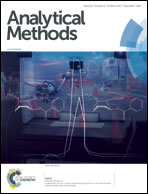Fine classification and untargeted detection of multiple adulterants of Gastrodia elata BI. (GE) by near-infrared spectroscopy coupled with chemometrics
Abstract
Adulterations and geographical origins are two essential quality factors of foods and herbs. In this work, the authentication of a traditional Chinese herb, Gastrodia elata BI. (GE), against artificial frauds and fine classification of geographical origins, was performed using near-infrared (NIR) spectroscopy and chemometrics. Class models of representative and authentic GE samples collected from different geographical origins were developed using one-class partial least squares (OCPLS) for untargeted detection of 4 common exogenous adulterants, including taro starch, sweet potato starch, potato starch and Polygonatum sibiricum powder. Fine classification of GE samples from 14 geographical origins was performed using a new large-class-number classification strategy, interval-combination one-versus-one partial least squares discriminant analysis (IC-OVO-PLSDA). Different data preprocessing methods were investigated to improve the classification accuracy of models. As a result, OCPLS with second-order derivative (D2) spectra could detect 1.0% (w/w) or higher levels of 4 different adulterants and obtain a sensitivity of 0.9107. For fine classification of geographical origins, a total classification accuracy of 0.9250 was achieved by IC-OVO-PLSDA with standard normal variate (SNV) spectra. The study demonstrates the potential of using NIR combined with chemometrics for the authentication of pure GE against multiple adulterants and fine classification of geographical origins.



 Please wait while we load your content...
Please wait while we load your content...